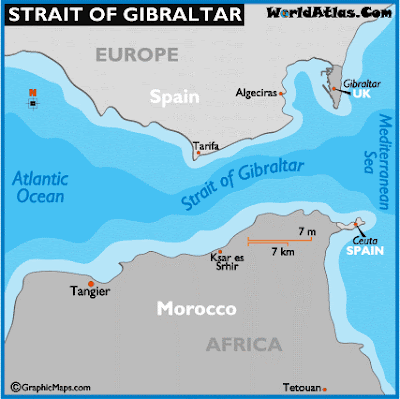1. C. Baltic Sea
Baltic Sea, an arm of the North Atlantic Ocean, extends northward
from the latitude of southern Denmark almost to the Arctic Circle and separates
the Scandinavian Peninsula from the rest of continental Europe. The many names
for the sea attest to its strategic position as a meeting place of many
countries. Proceeding clockwise from the west, the countries bounding the
Baltic are Denmark, Sweden, Finland, Russia, Estonia, Latvia, Lithuania, Poland
and Germany. The people of Sweden call it the "East Sea" while people
of Estonia call it as "West Sea".
The Baltic Sea is connected by artificial waterways to the White
Sea via the White Sea–Baltic Canal and to the German Bight of the North Sea via
the Kiel Canal, one of the world's busiest artificial waterways.
2. B. 200
An "Exclusive Economic Zone" (EEZ) is a
sea zone prescribed by the 1982 United Nations Convention on the Law of the Sea
(UNCLOS) over which a sovereign state has special rights regarding the
exploration and use of marine resources, including energy production from water
and wind. It stretches from the baseline out to 200 nautical miles (nmi) from
its coast.
(The World's exclusive economic
zones, shown in dark blue)
In colloquial usage, the term may include the continental shelf. The
term does not include either the territorial sea or the continental shelf
beyond the 200 nmi limit. The difference between the territorial sea (As per
the UNCLOS, the territorial sea is a belt of coastal waters that extends from
the baseline to 12 nautical miles) and the exclusive economic zone is that the
first confers full sovereignty over the waters, whereas the second is merely a
"sovereign right" which refers to the coastal state's rights below
the surface of the sea.
3. B. Rodriguez Point
The "Rodrigues Triple Junction" (RTJ), also known as the
"Central Indian [Ocean] Triple Junction" (CITJ) is a geologic triple
junction in the southern Indian Ocean where three tectonic plates meet: "the
African Plate", "the Indo-Australian Plate", and "the
Antarctic Plate". The triple junction is named for the island of "Rodrigues"
which lies 1,000 km (620 mi) north-west of it.
The boundaries of the three plates which meet at the "Rodrigues
Triple Junction" are all oceanic spreading centers, making it an R-R-R (Ridge-Ridge-Ridge)
type triple junction. They are: the "Central Indian Ridge" (CIR,
between the African and Indo-Australian plates) with a spreading rate of 50
mm/yr; the "Southwest Indian Ridg"e (SWIR, between the African and
Antarctic plates) 16 mm/yr; and the "Southeast Indian Ridge" (SEIR,
between the Indo-Australian and Antarctic plates) 60 mm/yr.
4. A. Canada
Canada, the second-largest country in the world
with a total area of 9,984,670 km2, has the longest coastline of all the
countries in the world - a staggering 202,080 kilometres. The Canadian Arctic
Archipelago, which consists of 36,563 islands, contributes to the total length
of the coastline of Canada.
Indonesia, with a coastline measuring 54,716
kilometres has the second longest coastline in the world.
5. B. Drake Passage
"Drake
Passage", deep waterway, 1,000 km wide, connecting the Atlantic and
Pacific oceans between Cape Horn (the southernmost point of South America) and
the South Shetland Islands, situated about 160 km north of the Antarctic
Peninsula. The Drake Passage defines the zone of climatic transition separating
the cool, humid, subpolar conditions of Tierra del Fuego (the southernmost tip
of the South American mainland) and the frigid, polar regions of Antarctica.
Though
bearing the name of the famous English seaman and global circumnavigator "Sir
Francis Drake", the passage was first traversed in 1616 by a Flemish expedition
led by "Willem Schouten". The Drake Passage played an important part in the trade
of the 19th and early 20th centuries before the opening of the Panama Canal in
1914.
































